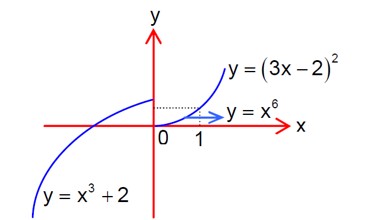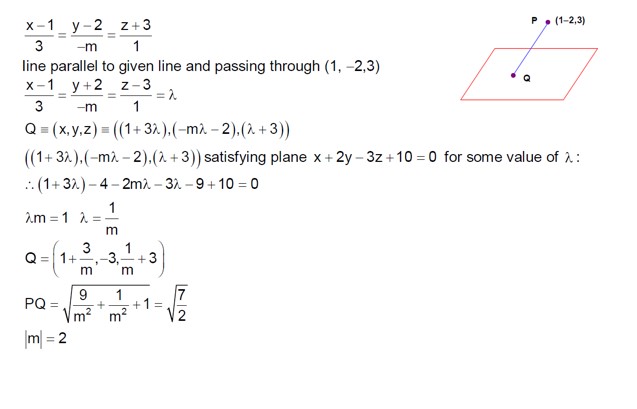Class 12th
Get insights from 12k questions on Class 12th, answered by students, alumni, and experts. You may also ask and answer any question you like about Class 12th
Follow Ask QuestionQuestions
Discussions
Active Users
Followers
New answer posted
2 months agoContributor-Level 9
Given f (g (x) is defined piecewise:
f (g (x) =
x³ + 2 ; x < 0
x? ; 0? x < 1
(3x - 2)² ; x? 1
fog (x) is discontinuous at x = 0.? non differentiable.
fog (x) is not differentiable at x = 0.
New answer posted
2 months agoContributor-Level 10
Using Lagrange's Mean Value Theorem (LMVT) for x ∈ [−7, -1].
[f (-1) - f (-7)] / [-1 - (-7)] ≤ 2
[f (-1) - (-3)] / 6 ≤ 2
f (-1) + 3 ≤ 12
f (-1) ≤ 9
Using LMVT for x ∈ [−7, 0].
[f (0) - f (-7)] / [0 - (-7)] ≤ 2
[f (0) - (-3)] / 7 ≤ 2
f (0) + 3 ≤ 14
f (0) ≤ 11
Therefore, f (0) + f (-1) ≤ 11 + 9 = 20.
New answer posted
2 months agoContributor-Level 10
Answer given by NTS is (1) which is wrong.
I = 1/ (a+b) ∫? x [f (x) + f (x+1)]dx . (1)
Using the property x → a + b - x
I = 1/ (a+b) ∫? (a+b-x) [f (a+b-x) + f (a+b+1-x)]dx
Given f (a+b+1-x) = f (x)
I = 1/ (a+b) ∫? (a+b-x) [f (x+1) + f (x)]dx . (2)
Adding (1) and (2):
2I = 1/ (a+b) ∫? (a+b) [f (x) + f (x+1)]dx
2I = ∫? [f (x) + f (x+1)]dx
2I = ∫? f (x)dx + ∫? f (x+1)dx
Let x+1 = t in the second integral, so dx = dt.
When x=a, t=a+1. When x=b, t=b+1.
∫? f (x+1)dx = ∫? ¹ f (t)dt = ∫? ¹ f (x)dx
New answer posted
2 months agoContributor-Level 10
c = λ (a x b).
a = I + j - k
b = I + 2j + k
a x b = | I j k |
| 1 -1 |
| 1 2 1 |
= I (1 - (-2) - j (1 - (-1) + k (2-1) = 3i - 2j + k.
c = λ (3i - 2j + k).
Given c ⋅ (i + j + 3k) = 8.
λ (3i - 2j + k) ⋅ (i + j + 3k) = 8
λ (3 - 2 + 3) = 8 => 4λ = 8 => λ = 2.
c = 2 (a x b).
We need to find c ⋅ (a x b).
c ⋅ (a x b) = 2 (a x b) ⋅ (a x b) = 2|a x b|².
|a x b|² = 3² + (-2)² + 1² = 9 + 4 + 1 = 14.
So, c ⋅ (a x b) = 2 * 14 = 28.
New answer posted
2 months agoContributor-Level 10
f (x) = {x+a, if x<0; |x-1|, if x0}
g (x) = {x+1, if x<0; (x-1)+b, if x0}
g (f (x) must be continuous. The potential points of discontinuity are where the definitions of f (x) and g (f (x) change. This is at x=0 and where f (x)=0.
f (x)=0 when x=-a (if a>0) or when x=1.
Continuity at x = 0:
lim (x→0? ) g (f (x) = lim (x→0? ) g (x+a). Since a could be anything, let's analyze f (0? )=a. So, lim is g (a).
lim (x→0? ) g (f (x) = g (f (0? ) = g (|0-1|) = g (1). Since 1≥0, g (1) = (1-1)²+b = b.
g (f (0) = g (|0-1|) = g (1) = b.
So we need g (a) = b.
Case 1: a < 0. g (a) = a+1. So a+1=b.
Case 2: a ≥ 0. g (a) = (a-1)²+b. So (a-1)²+b=b => (a-1)²=0 => a=1.
Now consider continuity at x=-a (assuming a>0).
l
New answer posted
2 months agoContributor-Level 10
[a? ] = [ 1 ] [-1 b? ]
[a? ] [√3 k] [ k b? ] (This is likely incorrect OCR, should be a 2x1 result)
The solution seems to derive from a matrix multiplication:
[√3a? ] = [ 1 ] [b? ]
[√3a? ] [√3 k] [b? ]
This leads to:
b? - b? = √3a?
b? + kb? = √3a?
Also given: a? ² + a? ² = (2/3) (b? ² + b? ²).
Squaring and adding the two derived equations and comparing with the given condition leads to k=1.
New answer posted
2 months agoContributor-Level 10
The integral is I = ∫ [ (x²-1) + tan? ¹ (x + 1/x)] / [ (x? +3x²+1)tan? ¹ (x+1/x)] dx
This is a complex integral. The provided solution splits it into two parts:
I? = ∫ (x²-1) / [ (x? +3x²+1)tan? ¹ (x+1/x)] dx
I? = ∫ 1 / (x? +3x²+1) dx
The solution proceeds with substitutions which are hard to follow due to OCR quality, but it seems to compare the final result with a given form to find coefficients α, β, γ, δ. The final expression shown is:
10 (α + βγ + δ) = 10 (1 + (1/2√5)*√5 + 1/2) seems incorrect.
The calculation is shown as 10 (1 + 1/10 - 1/2) = 10 (11/10 - 5/10) = 10 (6/10) = 6.
Taking an Exam? Selecting a College?
Get authentic answers from experts, students and alumni that you won't find anywhere else
Sign Up on ShikshaOn Shiksha, get access to
- 65k Colleges
- 1.2k Exams
- 679k Reviews
- 1800k Answers




